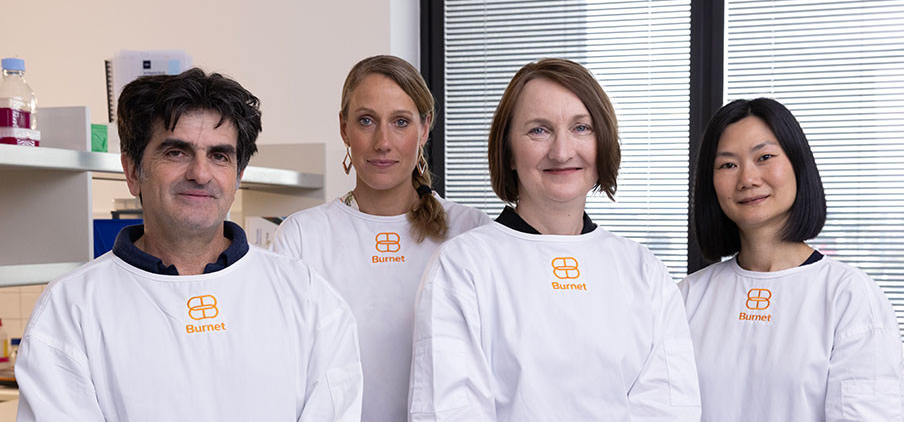
Hepatitis B and C
In Australia and worldwide, the hepatitis B and hepatitis C viruses are a significant cause of liver disease and liver cancer. The World Health Organisation has set targets to eliminate hepatitis B and hepatitis C as public health threats by 2030. Burnet Institute supports these targets by working to stop new infections and improve health services for people already infected.
Burnet collaborates with people and communities affected by hepatitis B and hepatitis C. We also work with researchers, scientists, government, health services and community organisations.
These partnerships deliver sustainable projects that serve common goals including:
-
improved harm reduction and prevention programs
-
vaccine development and improved vaccine access
-
innovative point-of-care diagnostics
-
improved access to testing and treatment.
Stories
View 32 moreNHMRC funding boost for hepatitis C elimination
Burnet will use the AUD$5 million to identify new ways of engaging the estimated 70,000 Australians living with Hepatitis C virus to receive care.

Burnet is part of global effort to prevent hepatitis C
Burnet Institute and partners have received US$31 million from global health agency Unitaid for an international harm reduction program.

Global project aiming to 'break down' hepatitis C
On World Hepatitis Day, Burnet is actively supporting this year’s theme – ‘Let’s Break It Down’ – through our partnership in a global program to develop high-quality approaches to testing and treatment.
Understanding the challenges
Hepatitis B
Hepatitis B is a viral infection. It can cause liver inflammation, liver cirrhosis, liver failure and liver cancer. Every minute, 2 people die globally from hepatitis B-related liver disease.
The most common hepatitis B transmission is from mother to child. It can also be transmitted through sex and blood-to-blood contact.
Hepatitis B can be deadly without clinical care. Although there is currently no cure for hepatitis B, it can be successfully managed with monitoring and medication (antivirals). Antivirals can stop the progression of liver disease and reduce cancer risk, helping people stay well for many years.
Hepatitis C
Hepatitis C is a viral infection. If left untreated, a hepatitis C virus infection can cause liver inflammation, liver cirrhosis, liver damage, liver failure and liver cancer. It is mostly transmitted by blood-to-blood contact.
In 2016, a hepatitis C cure (known as direct acting antiviral therapy) was introduced in Australia. Since then, more than 60% of Australians infected with hepatitis C have been cured.
Around the world, uptake of hepatitis C treatment is low. In many countries, people remain undiagnosed and untreated. It is critically important that more people get tested and treated for hepatitis C.
The most common way hepatitis C is transmitted in Australia and many other countries, is by injecting drug use without clean needles and syringes. Providing clean needles and syringes and opioid agonist therapy can prevent primary hepatitis C infection and reinfection. These are harm-reduction approaches, which means we focus more on reducing the negative impacts of injecting drug use rather than solely trying to prevent it.
Hepatitis C and injecting drug use can lead to stigma and discrimination. This can prevent affected people from accessing health care.
Our work focuses on developing models of care – such as harm reduction, treating hepatitis C, and curing hepatitis C – that meet people on their terms.
Our expertise
Working closely with affected communities, we aim to increase prevention, testing and treatment of viral hepatitis in community and clinical settings.
We take a multidisciplinary approach. This includes:
-
discovery science
-
co-design,community engagement, implementation science and clinical trials
-
surveillance and mathematical modelling.
Discovery science
We are developing new point-of-care diagnostic tests to help provide care for hepatitis C in community settings.
In collaboration with global partners, we are working to develop a hepatitis C vaccine.
Co-design, community engagement, implementation science and clinical trials
We bring together people diagnosed with, or at risk of, viral hepatitis and service providers to identify innovative approaches to hepatitis C care.
People at risk include:
-
people who inject drugs
-
people from Indigenous communities
-
culturally and linguistically diverse communities.
Service providers include:
-
pharmacies
-
general practice
-
other primary care services.
This collaborative approach helps improve health outcomes for people with hepatitis B and hepatitis C.
Key examples of this approach include:
-
The EXPAND-C program, which aims to increase hepatitis C testing and treatment through community pharmacies.
-
The It’s Your Right project, a peer-led hepatitis C health campaign for people who inject drugs.
-
A new partnership with people from culturally and linguistically diverse communities to increase awareness and engagement in hepatitis B care and cancer prevention.
We also work in the justice health sector to:
-
reduce hepatitis C transmission among people in prison, a group with known high hepatitis C prevalence
-
design models of care for people involved in the criminal justice system, seeking to improve the accessibility of testing and treatment.
Surveillance and mathematical modelling
We analyse surveillance data to identify changes in testing and treatment that could affect whether Australia’s goals to eliminate hepatitis C are achieved.
Our qualitative research analyses how health systems can respond more effectively to the lived experience of communities most affected by hepatitis B or hepatitis C.
We use mathematical modelling to assess the impact and cost-effectiveness of interventions to improve prevention, diagnosis and treatment of hepatitis B and hepatitis C.
Our achievements and current work
Hepatitis B
Our work on hepatitis B has shown that community-based hepatitis B care should be tailored depending on:
-
the culture of the people we are targeting for care, particularly in Australia where there are many culturally and linguistically diverse (CALD) communities
-
the prevalence of hepatitis B in the community with whom we are working.
In Australia, healthcare should also be enabled by structuring the health system to support people from CALD communities. This includes providing educational materials in multiple languages, interpreters and peer support groups.
Simply-B is a project investigating ways to improve how primary care and hospitals work together to ensure people at risk of hepatitis B are tested, treated and maintained in care.
Separate work underway in Vanuatu aims to increase pregnant women's access to hepatitis B treatment to stop mother to child transmission.
Burnet has identified cost-effective ways to improve the delivery and management of the hepatitis B birth dose (HepB-BD) vaccine. If implemented, these measures would prevent 36.3 million years of life lost to ill health, disability or early death resulting from hepatitis B.
Hepatitis C
Hepatitis C vaccine development
Our discovery science research defined how the hepatitis C virus enters cells and evades immunity.
We used this knowledge to design vaccine candidates that generate broad, protective immune responses and identify key viral entry mechanisms. These insights inform hepatitis C vaccine development.
Hepatitis C models of care
Our Treatment and Prevention Study, was a world-first study on a specific nurse-led model of care to treat people who inject drugs and their injecting partners with a new direct-acting antiviral therapy to cure their hepatitis C.
Our Prime Study was a world-first study that compared the effectiveness of hepatitis care in community-based clinics with tertiary hospital care. The conclusion: hepatitis C treatment in primary care increases treatment uptake and cure.
We work to streamline prison systems for hepatitis care. We do this by developing guidelines and recommendations for in-prison prevention, testing, treatment and care.
Policy development and global partnerships
To support global elimination goals, we collaborated on the development of the first World Health Organisation guidelines for hepatitis C screening care and treatment.
We also established the Eliminate Hepatitis C Australia (EC Australia) partnership in pursuit of these goals. The initiative unites researchers, implementation scientists, government, health services and community organisations.
Featured publications
Changes in incidence of hepatitis C virus reinfection and access to direct-acting antiviral therapies in people with HIV from six countries, 2010–19: an analysis of data from a consortium of prospective cohort studies
The Lancet HIV
Rachel Sacks‐Davis et al
A global investment case for hepatitis B elimination: a modelling study
˜The œLancet. Gastroenterology & hepatology
Chris Seaman et al
Pathway to global elimination of hepatitis B: HBV cure is just the first step
Hepatology
Jessica Howell et al
Outcomes of the CT2 study: A ‘one‐stop‐shop’ for community‐based hepatitis C testing and treatment in Yangon, Myanmar
Liver International
Bridget Draper et al
Global hepatitis C elimination: an investment framework
˜The œLancet. Gastroenterology & hepatology
Alisa Pedrana et al
Outcomes of Treatment for Hepatitis C in Primary Care, Compared to Hospital-based Care: A Randomized, Controlled Trial in People Who Inject Drugs
Clinical Infectious Diseases
Amanda Wade et al
Our projects
View 53 more
Eliminate Hepatitis C Australia (EC Australia)
Partnering to eliminate hepatitis C as a public health threat by 2030.

Triple Elimination Toolkit for Pacific island countries
The Triple Elimination Toolkit project aims to help Pacific island countries meet elimination targets for HIV, syphilis and hepatitis B.

Eliminate C (EC) Victoria partnership
A partnership aimed at increasing hepatitis C treatment uptake among people who inject drugs (PWID) using nurse-led models of care in community and prison settings.
Our working groups



Alcohol and Other Drugs group


Bioinformatics group



Burnet Diagnostics Initiative (BDI)



Global Health: Policy, Practice and Community Action group



Hepatitis B and Liver Cancer group



HIV and Sexually Transmitted Infection Prevention group



Immune Therapies group



Infection, Inflammation and Innate Immunity group



Infectious Diseases Clinical Research group



Infectious Diseases Implementation Science group



Justice Health group



Modelling and Biostatistics group



Pacific Infectious Diseases (Operational Research, Surveillance and Resilience) group



Surveillance and Data Linkage group



Viral Entry and Vaccines group




